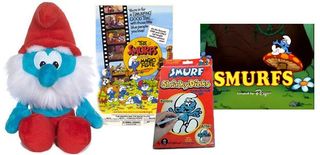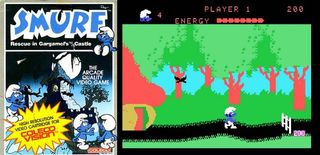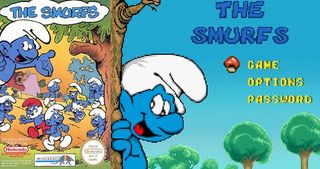The horrible, horrible history of Smurfs games
The smurfiest piles of smurf the world has ever smurfed
Let’s make this brief: The Smurfs made their first appearance in long running Belgian comic written by Pierre “Peyo” Culliford in 1958. That story’s popularity saw them spun off into their own publication a year later, spawned a ton of merchandise, two animated films in 1965 and 1976, basically invented zombies, and then came a Hanna-Barbera cartoon series which dominated the Saturday morning airwaves for a ridiculous run of nine seasons.

Above: Who gives a shit?
Assuming you spent any amount of time being a kid in the 80’s, odds are you share some history with The Smurfs. Whether or not you’re proud of that is of no importance here… I’m sure we’re all in agreement that the new movie looks fucking terrible. So, we’re riding that crest of nostalgic spite right into the magical village of games, and taking a look back at The Smurfs’ contribution to interactive entertainment. I think you’ll find each and every one serves as a fittingly atrocious precursor to the shiny Hollywood turd set to light up the big screen nationwide.
Smurfs: Rescue from Gargamel%26rsquo;s Castle | 1982

Right out of the gate, the world’s first Smurfs game landed with a deafening, hilarious thud. While kids everywhere were scrambling to get ahold of all things Smurfy AND grasp the burgeoning medium of gaming, Colecovision went and made one of the least intuitive, frustratingly difficult video games of all time.
I suppose when you’re an inch or two tall EVERYTHING has the potential to be deadly, and Christ, was that a notion Rescue from Gargamel’s Castle really ran with. Bats kill you, fences kill you, BLADES OF GRASS kill you.
Sign up to the 12DOVE Newsletter
Weekly digests, tales from the communities you love, and more

Above: Mind the Death Grass!
The only skill in your arsenal to overcome the now-nefarious, everyday obstacles was jumping, which Coleco cruelly made one of the most confusing, unintuitive inputs of all time. The only way to jump over stuff was to hop straight up in the air first, then jump a second time to move forward. If that weren’t enough to send children crying into the arms of Shirt Tales, there’s even a glitch in the last room that made Smurfette appear topless for a bit of unintentional Smurf Smut!
Smurfs Paint N Play Workshop | 1984
Lesson learned! If you’re not capable of creating a game that kids can actually play, put out a game that kids create themselves. And that’s basically what Coleco did, following up its laughable attempt at a sidescoller with a free-form artistic endeavor that let kids create whatever they wanted (within the legal parameters of Hanna-Barbera’s trademark, all rights reserved).

In short, it was just like a coloring book! I mean, assuming your coloring books required stamps shaped like enormous pixels instead of crayons.
The Smurfs | 1994-1997

HO BOY! Console gaming had found its legs, and Infogrames used the power of about a dozen consoles to pull off some of the most unremarkable games the world had ever seen.

Above: The Black “Zombie” Smurf actually appears in the NES version, even though Hanna-Barbera had colored them purple on TV in a ball-less act of racial sensitivity
Okay, maybe you could excuse the NES/Master System version, but only judging by the sadistic standards of 8-bit sidescollers. The music was bouncy and the levels had colorful variety – let’s go ahead and give it that. But you were largely defenseless and anything that moved spelled three-hit murder for the poor blue creatures once again questing to rescue kidnapped Smurfs (it never ends!)

Above: Death can come from anywhere
The 16-bit versions, however, are a different beast entirely - and goddammit! – someone should’ve known better. While the animation was more fluid, and arguably more representative of the cartoon show American audiences were rapidly forgetting, it learned nothing from the punishing Coleco version.

Above “HEY, THANKS BUDDY! It’s not like our continued existence is on the line!”
Armed with yet another hyper-flawed jumping mechanic, everything was again ridiculously lethal. Not only do standing puddles of water bring about your mortal end, fellow Smurfs pop out randomly to kill you on your journey to save them.
Above: Interestingly, the Genesis version’s biggest sin was stealing Sonic the Hedgehog’s drummer












